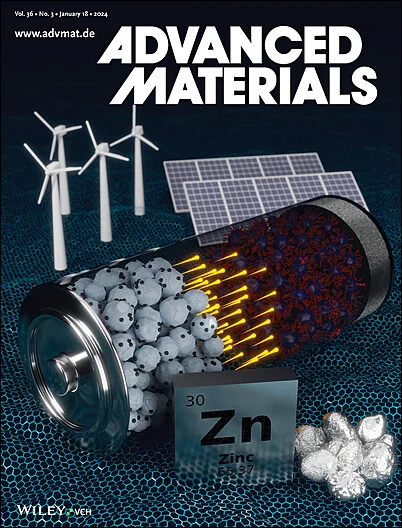Interfacial Coordination Engineering to Boost Li‐Ion Conduction in Economic Zr‐Based Halide Electrolytes
IF 27.4
1区 材料科学
Q1 CHEMISTRY, MULTIDISCIPLINARY
引用次数: 0
Abstract
Halide solid electrolytes (HSEs) have seen rapid progress in the development of all‐solid‐state lithium batteries (ASSLBs), offering favorable lithium‐ion transport properties, broad electrochemical stability, and strong interfacial compatibility with high‐voltage oxide cathodes. However, developing HSEs that simultaneously offer high ionic conductivity and low cost remains a significant challenge. Most high‐conductivity halides rely on expensive metal elements, whereas cost‐effective Zr‐based halides are limited by their relatively low ionic conductivity. In this study, a new composite electrolyte (LA/LZCO) is developed via an interfacial coordination reaction between Zr‐based oxychlorides (LZCO) and Li界面配位工程促进经济的Zr基卤化物电解质中Li离子的传导
卤化物固体电解质(HSEs)在全固态锂电池(ASSLBs)的发展中取得了快速进展,具有良好的锂离子传输性能,广泛的电化学稳定性以及与高压氧化物阴极的强界面相容性。然而,开发同时提供高离子电导率和低成本的hse仍然是一个重大挑战。大多数高导电性卤化物依赖于昂贵的金属元素,而具有成本效益的Zr基卤化物则受到其相对较低的离子导电性的限制。本研究通过Zr基氧氯化物(LZCO)与Li1.3Al0.3Ti1.7(PO4)3 (LATP)的界面配位反应,制备了一种新型复合电解质LA/LZCO。LATP中的PO43−基团与LZCO中的Zr4+之间的配位导致了LZCO的局部结构紊乱,促进了LZCO的非晶化。结果表明,LA/LZCO复合电解质的离子电导率比LZCO提高了两倍以上,达到2.81 mS cm−1,是目前报道的Zr基卤化物电解质中离子电导率最高的电解质之一。当与NCM83125阴极集成到asslb时,复合电解质具有出色的循环稳定性,在0.5和2 C下4.25 V下循环1000次后,容量保持率分别为92.4%和87.5%。即使在4.5 V的高截止电压下,380次循环后仍能保持85.1%的容量,这突出了这种复合策略对高能、长寿命assb的承诺。
本文章由计算机程序翻译,如有差异,请以英文原文为准。
求助全文
约1分钟内获得全文
求助全文
来源期刊

Advanced Materials
工程技术-材料科学:综合
CiteScore
43.00
自引率
4.10%
发文量
2182
审稿时长
2 months
期刊介绍:
Advanced Materials, one of the world's most prestigious journals and the foundation of the Advanced portfolio, is the home of choice for best-in-class materials science for more than 30 years. Following this fast-growing and interdisciplinary field, we are considering and publishing the most important discoveries on any and all materials from materials scientists, chemists, physicists, engineers as well as health and life scientists and bringing you the latest results and trends in modern materials-related research every week.
 求助内容:
求助内容: 应助结果提醒方式:
应助结果提醒方式:


